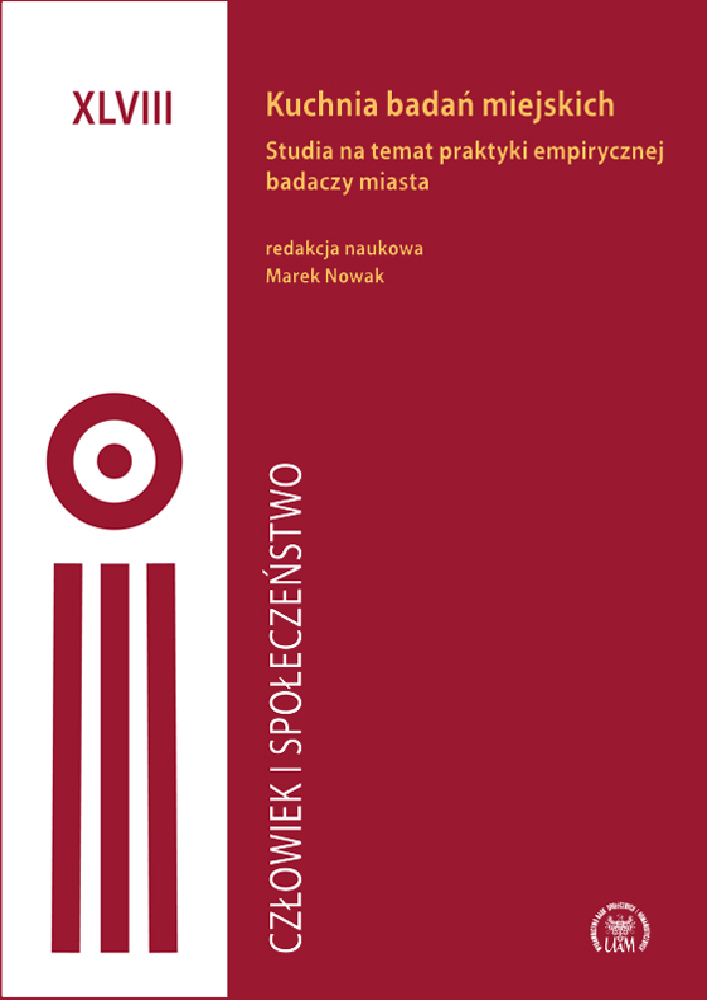Abstrakt
The purpose of the article is to critically discuss the methodology for measuring „urban scenes” which has been proposed by contemporary Chicago School. The author presents the assumptions and conceptual-analytical framework of scene theory, and then discusses the consecutive steps of the research strategy developed by this theory. The author refers to her research experience in using the scene approach and points to challenges and problems in the application of the scene theory, as well as proposes some strategies of overcoming them.
Marta Klekotko, Marta Klekotko, Matematyka kultury, czyli jak policzyć charakter kulturowy miasta? [Marta Klekotko, Matematyka kultury, czyli jak policzyć charakter kulturowy miasta? [Mathematics of culture: how to measure cultural character of a city?] edited by M. Nowak, „Człowiek i Społeczeństwo” vol. XLVIII: Kuchnia badań miejskich. Studia na temat praktyki empirycznej badaczy miasta [A backstage of urban research. Studies on the empirical practices of city research scientists], Poznań 2019, pp. 13–34, Adam Mickiewicz University. ISSN 0239-3271.
Marta Klekotko, Uniwersytet Jagielloński, Instytut Socjologii UJ, ul. Grodzka 52, 31-044 Kraków, e-mail: marta.klekotko@uj.edu.pl
Bibliografia
Borer, M.I. (2006). The Location of Culture: The Urban Culturalist Perspective. City and Community, 5(2), 173–197.
Brooks, D. (2000). Bobos in Paradise: The New Upper Class and Howe They Got There. New York: Simon and Schuster.
Chatterton, P., Hollands, R. (2002). Theorising urban playscapes: Producing, regulating and consuming youthful nightlife city spaces. Urban Studies, 39(1), 96–116.
Clark, T.N. (2003a). The City as an Entertainment Machine. Oxford: Elsevier.
Clark, T.N. (2003b). Urban amenities: Lakes, opera and juice bars. Do they drive development? W: T.N. Clark (red.), The City as an Entertainment Machine, Oxford: Elsevier.
Clark, T.N. (2007). Making culture into magic: How can it bring tourist and residents? International Review of Public Administration, 12(1), 13–26.
Clark, T.N., Lloyd, R., Wong, K.K., Jaiun, P. (2001). Amenities drive urban growth? Journal of Urban Affairs, 24(5), 493–515.
Florida, R. (2002a). Bohemia and economic geography. Journal of Economic Geography, 2, 55–71.
Florida, R. (2002b). The economic geography of talent. Annals of American Geographers, 92(4), 743–755.
Florida, R. (2002c). The Rise of the Creative Class. New York: Basic Books.
Gieryn, T.F. (2000). A space for sociology. Annual Review of Sociology, 26, 463–496.
Glaeser, E., Kolko, J., Saiz, A. (2001). Consumer city. Journal of Economic Geography, 1, 27–50.
Judd, D.R., Fainstein, S.S. (1999). The Tourist City. New Heaven: Yale University Press.
Kaple, D.A., Morris, L., Riukin-Fush, Z., Dimaggio, L. (1996). Data on Arts Organizations: A Review and Needs Assessments, with Design Implications (working paper 1). Princeton: Centre for Arts and Cultural Policy Studies, Princeton University Press.
Klekotko, M., Navarro, C.J. (red.). (2015). Wymiary kulturowe polskich miast i miasteczek. Kraków: Wydawnictwo Uniwersytetu Jagiellońskiego.
Klekotko, M., Navarro, C.J. (2018). Manual for Scenes Research, paper presented at RC 03 session on „Urban Scenes”. Toronto: World Congress of International Sociological Association (typescript).
Klekotko, M., Navarro, C.J., Silver, D., Clark, T.N. (2015). Wymiary i charakter kulturowy miasta. W: M. Klekotko, C.J. Navarro (red.), Wymiary kulturowe polskich miast i miasteczek (ss. 13–60). Kraków: Wydawnictwo Uniwersytetu Jagiellońskiego.
Landry, C. (2006a). Lineages of creative city. Research of Journal for Creative Cities, 1(1), 15–23.
Landry, C. (2006b). The Art of City Making. London: Earthscan.
Lloyd, R. (2007). Neo-bohemia: Art and Commerce in the Postindustrial City. New York: Routledge.
Lucchini, F. (2002). La culture au service des villes. Paris: Economica.
Markusen, S. (2006). Urban Development and the Politics of Creative Class: Evidence from the Study of Artists. Environment and Planning, 38, 1921–1940.
Navarro, C.J., Guerrero, G., Mateos, C., Muñoz, L. (2012). Escenas culturales, desigualdades y gentrificación en grandes ciudades españolas. Los casos de Barcelona, Bilbao, Madrid y Sevilla. W: J. Cucó (red.), Metamorfosis urbanas (ss. 109–132). Barcelona: Icaria.
Page, S. (1995). Urban Tourism. London: Routledge.
Rothfield, L. (1999). Cultural Policy Studies?!: A Guide for Perplexed Humanists (working paper). Chicago: Cultural Policy Center, University of Chicago.
Schuster, J.N. (2002). Informing Cultural Policy: The Research and Information Infrastructure. Bristol: Centre for Urban Policy Research.
Silver, D., Clark, T.N. (2016). Scenescapes: How Qualities of Place Shape Social Life. Chicago: University of Chicago Press.
Silver, D., Clark, T.N., Graziul, Ch. (2011). Scenes, innovation and urban development. W: D.E. Anderson, A.E. Anderson, Ch. Mellander (red.), Handbook of Creative Cities (ss. 229–258). Cheltenham–Northampton: Edward Elgar Publishing.
Silver, D., Clark, T.N., Navarro, C.J. (2010). Scenes: social context in an age of contingency. Social Forces, 88(5), 2293–2324.
Silver, D., Clark, T.N., Rothfield, L. (2007). A Theory of Scenes. Chicago: University of Chicago (typescript).
Zukin, S. (1995). The Culture of Cities. London: Blackwell.
Licencja
1. W momencie złożenia pracy celem rozpoczęcia postępowania w sprawie publikacji, Licencjodawca, zwany dalej Autorem, akceptuje wszystkie zasady umieszczone na stronie internetowej czasopisma “Człowiek i Społeczeństwo”, udzielając Licencjobiorcy, zwanego dalej Wydawcą, niewyłącznej i nieodpłatnej licencji na korzystanie z Utworu. Licencja zakłada tym samym brak ograniczeń terytorialnych, czasowych oraz ilościowych na następujących polach eksploatacji (art. 50 ustawy z dnia 4 lutego 1994 r. o prawie autorskim i prawach pokrewnych):
a. utrwalanie Utworu;
b. zwielokrotnienie Utworu drukiem i w wersji cyfrowej;
c. wprowadzenie do obrotu, użyczenie lub najem oryginału/zwielokrotnionych egzemplarzy Utworu;
d. publiczne wykonanie, wystawienie, wyświetlenie, odtworzenie oraz nadawanie i reemitowanie, a także publiczne udostępnianie Utworu w taki sposób, aby każdy mógł mieć do niego dostęp w miejscu i w czasie przez siebie wybranym;
e. włączenie Utworu w skład utworu zbiorowego;
f. wprowadzenie Utworu w postaci elektronicznej na platformy elektroniczne lub inne wprowadzenie Utworu w postaci elektronicznej do Internetu, Intranetu, Extranetu lub innej sieci;
g. rozpowszechnianie Utworu w wersji elektronicznej w Internecie, Intranecie, Extranecie lub innej sieci, w pracy zbiorowej, a także samodzielnie w formule Open Access w oparciu o licencję Creative Commons Uznanie autorstwa 4.0 Międzynarodowa Licencja Publiczna (CC BY 4.0), a także inną wersję językową tej licencji, lub którąkolwiek późniejszą wersję tej licencji.
2. Założenia licencji Creative Commons Uznanie autorstwa 4.0 Międzynarodowa Licencja Publiczna (CC BY 4.0), udzielają Wydawcy upoważnienia do kopiowania, zmieniania, rozprowadzania, przedstawiania i wykonywania Utworu jedynie pod warunkiem uznania autorstwa.
3. Wraz z dostarczeniem Utworu, Autor zobowiązuje się do wypełnienia, podpisania oraz odesłania skanu umowy
